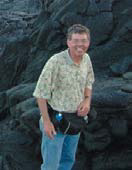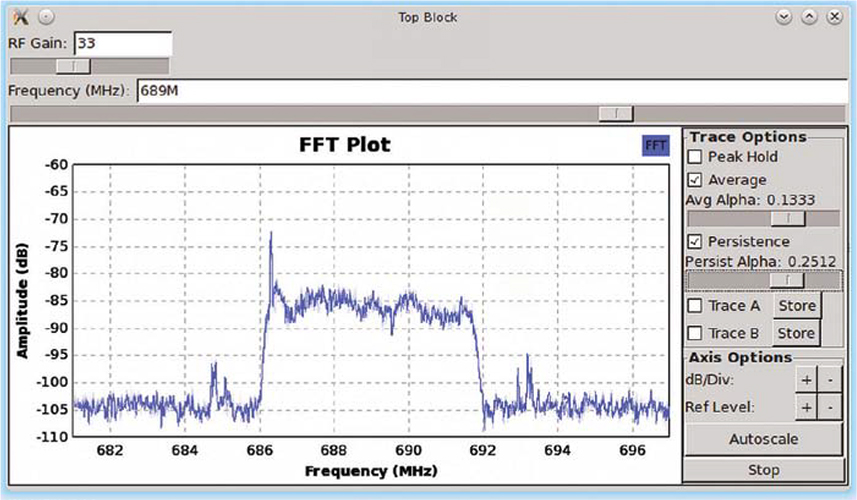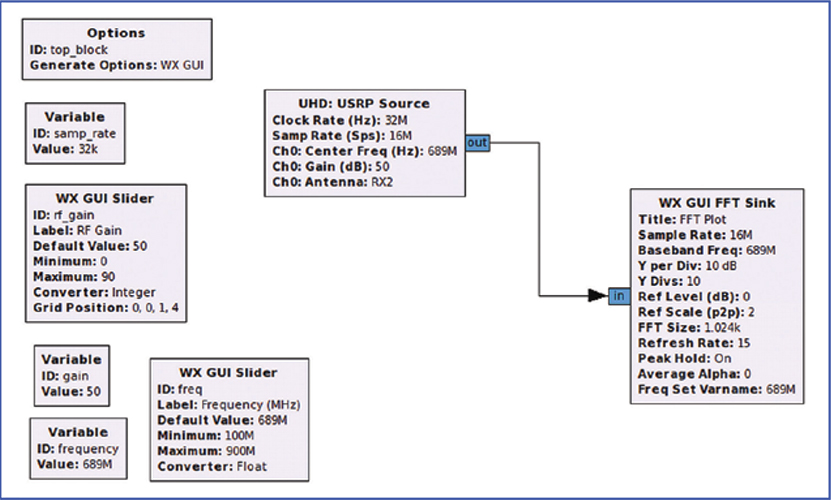
Doug Lung
Two years ago, I wrote about using an inexpensive RTL2832-based DVB/DAB USB dongle as a spectrum analyzer and receiver. (See “Software-Defined Radios Help Explore RF Spectrum,” July 11, 2012). It is still part of my travel toolkit, but when I can, I make room for an Ettus Research USRP B200. As with the RTL2832 dongles, software is available to use it as a receiver or spectrum analyzer. Unlike the cheap dongles, it includes a transmitter that allows it to be used as a simple antenna or filter analyzer with the addition of a directional coupler.
COST RANGE
The B200 is one of the relatively low-cost SDR boards now available that allow bandwidth on order of magnitude greater than that available with the inexpensive RTL2832 dongles.
The least expensive SDR board is the HackRF One, available for around $300. It can transmit or receive any radio signal between 10 and 6,000 MHz. The board is half-duplex only, so if you want to use it as a network analyzer you’ll need two boards. Maximum sample rate is 20 megasamples per second (Msps). Sample size is 8 bits each for I and Q outputs. (https://greatscottgadgets.com/hackrf/)
The lowest-cost, full-duplex SDR board is the bladeRF, which with a Cyclone IV FPGA, costs $420. Upgrading to a large 115KE Cyclone IV raises the price to $650. Frequency range is 300 to 3.8 GHz with independent receive/transmit and 12-bit, 40 Msps quadrature sampling. According to the product description, it can be used as a spectrum analyzer, vector signal analyzer, and vector signal generator. A case is available for $20. A transverter to allow operation from 60 kHz to 300 MHz is available for $200. (http://nuand.com/)
The Ettus Research B200 that I have is more expensive, at $675, but offers continuous coverage from 70 MHz to 6.0 GHz and can operate full duplex with up to 56 MHz of realtime bandwidth. ADC resolution is 12 bits with a maximum sample rate of 61.44 Msps. Ettus Research’s website doesn’t show a case option, but the Hammond 1455L1601 should work. I bought one from Digikey (PN HM896-ND) for $22.02, but it will take some metal work to make it usable. (www.ettus.com/product/details/UB200-KIT)
A USB 3.0 port is needed to obtain the maximum sample rate from the bladeRF and B200. The performance of USB 3.0 cards varies widely. See www.ettus.com/kb/detail/usrp-b200-and-b210-usb-30-streaming-ratebenchmarks for the results of tests Ettus conducted on USB 3.0 interfaces.
The professional video industry's #1 source for news, trends and product and tech information. Sign up below.
While I’m using the common acronym “SDR” to refer to these boards, “digitizer” is probably a more accurate term when most of the signal processing is being done on a separate device.

Fig. 1: SDR spectrum analyzer display

Fig. 2: SDR spectrum analyzer GRC block diagram Fig. 1 shows the output from a very simple spectrum analyzer built using GNU Radio companion (GRC). If you look at the controls on the display you’ll see they don’t match a conventional analyzer. FFT size, sample rate and other parameters are specified in the GRC blocks shown in Fig. 2.
The specified noise-figure for the B200 is “<8 dB.” To detect weak off-air ATSC signals, I added a Minicircuits ZX60-P103LN+. It is a 50–3000 MHz E-PHEMT LNA with a typical noise figure of 0.5 dB with high dynamic range that can be operated off a 5-volt USB supply. I recommend the ZX- 75BS-88108+, an 88–108 MHz band stop filter to avoid overload from strong FM radio signals. Minicircuits has low-pass and highpass filters that could be useful in different test and receiver applications. I used SMA connectors, cables and attenuators to keep the package small (www.minicircuits.com/).
The B200 or bladeRF full duplex SDRs can be turned into a simple scalar network analyzer by adding a directional coupler such as the Minicircuits ZFDC-20-4L. Fig. 3 shows the setup I’m using. Obviously, when testing an antenna, the 30 dB pad on the output would be removed.
VERY VERSATILE
Using an SDR as capable as the B200 or bladeRF for such simple tasks might be overkill, but consider what it would take to build such a device from scratch. Even assembling off-the-shelf modules would require soldering and some means of displaying and collecting the results of the measurements. These SDRs are capable of much more.
For example, knowing the phase of the signal leaving the SDR, doing a reference calibration and then measuring the amplitude and phase of the signal coming back through the directional coupler, it should be possible to build a two-port vector network analyzer. Add a second receiver, available in the Ettus B210, and you could build quite a complex network analyzer. That’s one of the project ideas for the 2015 Google Summer of Code: http://gnuradio.org/redmine/projects/gnuradio/wiki/GSoC.
GNU Radio includes an example program for receiving ATSC signals. It seems to me it should be possible to modify the program to display signal quality data such as MER and perhaps even generate constellation and eye-pattern diagrams.

Fig. 3: simple scalar analyzer using an SDR Another example program, designed for white-space experimentation, scans TV channels and generates a list of measured channel power for each of them. A Google search will bring up discussions and examples of programs to transmit and receive DVB-T.
In the GatesAir booth at this year’s NAB Show you could see an Ettus Research USRP N210 SDR being used to generate the DVB-T2 signal that included a future extension frame carrying an LTE signal.
Even though writing such a program is well beyond my skill level and, I imagine, that of most readers, broadcasters are seeing cost savings and advantages of SDR technology in the latest-generation ATSC and DVB exciters and in test equipment such as the Avateq AVQ1020 and Dektec DTU-215.
I’ll have more on the B200 and SDRs in general after I’ve had a chance to try some of the ATSC and DVB-T programs and extend the network analyzer capability.
Meanwhile, if you’ve started experimenting the one the new SDR boards, drop me an email at dlung@transmitter.com and share your experiences.

Doug Lung is one of America's foremost authorities on broadcast RF technology. As vice president of Broadcast Technology for NBCUniversal Local, H. Douglas Lung leads NBC and Telemundo-owned stations’ RF and transmission affairs, including microwave, radars, satellite uplinks, and FCC technical filings. Beginning his career in 1976 at KSCI in Los Angeles, Lung has nearly 50 years of experience in broadcast television engineering. Beginning in 1985, he led the engineering department for what was to become the Telemundo network and station group, assisting in the design, construction and installation of the company’s broadcast and cable facilities. Other projects include work on the launch of Hawaii’s first UHF TV station, the rollout and testing of the ATSC mobile-handheld standard, and software development related to the incentive auction TV spectrum repack. A longtime columnist for TV Technology, Doug is also a regular contributor to IEEE Broadcast Technology. He is the recipient of the 2023 NAB Television Engineering Award. He also received a Tech Leadership Award from TV Tech publisher Future plc in 2021 and is a member of the IEEE Broadcast Technology Society and the Society of Broadcast Engineers.
